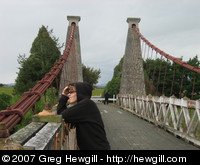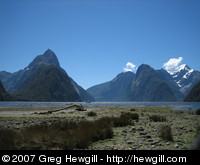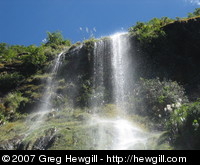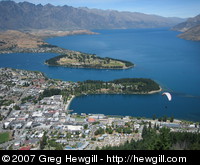Finally getting around to part 3 of the trip report. I've been a bit distracted by other events this week. You can also go back and read part 1 or part 2.
Sunday 30 December. From Invercargill, we headed first west then northish up to Te Anau. Southland has some very expansive beaches which could be very relaxing to spend time at. Lacking the time on this trip, we pushed on and stopped in Clifden to see a historic suspension bridge that is now a reserve. Nearby we visited the Clifden Caves which is a system of limestone caves in which we found glow worms. We couldn't make it all the way through the 300 m system because there was a bit too much water in the pool at the end, so we turned back. We stayed the night in a place just outside Te Anau because there was nowhere available in town that night.
Monday 31 December. Today we headed to Milford Sound for the day. Our original plans hadn't included Milford because we knew we would be kayaking in Doubtful Sound and there are approximately three orders of magnitude more people to be found in Milford. Nevertheless, we had an extra day due to schedule shifting so we drove on up. The scenery on the road to Milford was imposing as expected. We saw the Mirror Lakes and The Chasm, popular spots to stop and get attacked by sand flies (and take pictures). The weather was bright and sunny, so we took one of the many Milford Sound cruises around the fiord. We saw lots of seals, waterfalls, and various geology. Our boat nosed in to two waterfalls, and it was sunny and warm enough for me to completely dry out twice before the cruise returned, even though I stood directly under the waterfall both times. The fiords of Fiordland are really best experienced in wet weather, because the steep sides of the fiords do not have any soil so almost as soon as the rain stops, most of the waterfalls dry up. Although we didn't see Fiordland at its best this day, the best was yet to come...
Tuesday 1 January. We spent New Years Day in Te Anau, not doing too terribly much. We saw Ata Whenua, which is a film made by a local helicopter pilot over a period of many years. It's a short montage of video clips from some of the most rugged and impressive landscapes around. The guy who produced it couldn't get distribution, so he built his own cinema in Te Anau and that's the only place you can see it on the big screen (of course, they also sell it on DVD). At the end of the day we met with Fiordland Sea Kayaks, our guide for the following two days. The most important item on the agenda was the weather report - the forecast was for heavy rain and severe thunderstorms within the next 24 hours. Now, this is Fiordland where some parts get something like 7 metres of rain annually, so when they say "heavy" they mean "heavier than normal" which is torrential by any other standard. Regardless, we decided to check again in the morning and decide what to do at that time.
Wednesday 2 January. Bright and early, at 5:45 we got the news that the storm was slightly delayed, so the trip was still on and we would stay in a hostel in Deep Cove (which is normally used by school kids during the year but it's summer break now) instead of trying to camp. Just getting to Doubtful Sound is an adventure in itself. It requires a bus to the town of Manapouri (30 minutes), a ferry across Lake Manapouri (1 hour), and another bus to Deep Cove (45 minutes). On the way we saw the (top of the) Manapouri Power Station which is the largest hydroelectric generating station in New Zealand. The stretch of road between the power station and Deep Cove (where the water exits the station) was built specifically for the construction of the power station and is not actually connected to any other roads in New Zealand. Over Wilmot Pass and we got our first look at our world for the next couple of days. The weather was a bit windy and a bit rainy at the time because the severe thunderstorms were still on their way in. So we packed up the kayaks (including all our overnight gear just in case we got caught out, even though at that point we weren't planning to camp) and headed out. It had been mostly dry for a day or two before, so the waterfalls on the sides of the fiord were relatively mere trickles. We tried to go around Elizabeth Island, but the wind was a bit too much and we were running out of time, so headed back to Deep Cove for the night.
Thursday 3 January. As promised, we certainly did have a thunderstorm. It was sort of raining all night, but around 5 or 6 in the morning the sky really opened up, we had full thunder and lightning and absolutely torrential rain. We couldn't see much of the inlet at the time, but a bit later in the morning I got a post-rainfall waterfall (notice the power boat on the left and the relative size of the spray from the falls). It stayed rainy for a while and we were unsure whether we could kayak again that day. However, suddenly the weather cleared up, so we put the kayaks back in the water and headed out. We stopped at another serious waterfall (and got out and walked up to it - verywindy!). The walls of the fiord were blanketed in waterfalls, it was quite a sight to see. We couldn't have asked for better conditions - a heavy rainfall followed by bright blue skies. We stopped for lunch at one of the few places you could actually land a kayak on the shore. We couldn't spend much more time since we needed to get back to Te Anau that night, so we sailed back to Deep Cove, packed up, and headed out. We still had a bit of time to stop at the second tailrace tunnel of the Manapouri Power Station, which is a huge 10 km long, 10 metre wide tunnel through the mountains.
Friday 4 January. From Te Anau we drove up to Queenstown for a quick visit before we headed home. Amy had been up the gondola once before but I hadn't, so after some lunch we took a ride up there to take in the view. Queenstown bills itself as the centre of adventure sports in New Zealand, and that was certainly evident from the top. There was bungee, parasailing, paraskiing, and luge. We left the bustle of Queenstown before dinner and headed over Lindis Pass to Omarama.
Saturday 5 January. The Canterbury Gliding Club (of which I'm a member) essentially relocates to Omarama every year between mid-December and mid-February. I had hoped to be able to take a flight there, however the weather was unsuitable for gliding. It was a crystal clear day with blue skies, but the upper air temperatures and conditions were such that thermals would stop at about 3000 feet and nothing beyond that. I decided to give it a miss, and I'd be surprised if very many people flew that day at all (there was even a contest going on and they had cancelled it for that day). Because we were tired and ready to return home, we left Omarama before lunchtime and arrived home before dinner, with 2016 km on the odometer. Here's a link to a Google Map of our trip.




